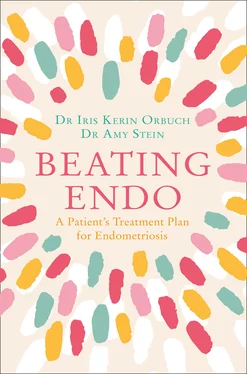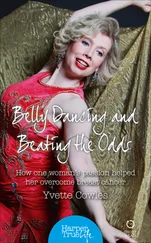An administrative assistant working for a high-profile senior vice president at a high-profile investment firm doesn’t get that much time off. Iris said Elena would need a week away from the office for surgery and rest at home (not to mention real healing, which can take as much as three months)—so Elena and her boss had to do some fancy stepping to get her the stretch of healthcare leave she needed for her excision surgery. It took another four months. The time was not wasted. Elena kept at the treatment plans for all of the coexisting conditions she and Iris had identified, and she saw dramatic progress in all of them except one: Her painful periods persisted—further indication that her endometriosis needed to be addressed by surgery. But she could sit comfortably now, only had her sleep interrupted “once a night at most” to urinate, and no longer strained as she once had to move her bowels.
She was also far less anxious, and each diminution of her pain, each easing of her body’s tightness reinforced that equanimity and strengthened her commitment to the changes she was undertaking. By the time she finally had her surgery, the nutritional principles and the exercise regimen, the mindfulness and movement practices that had once been lessons to learn had become second nature—automatic behaviors intrinsic to her lifestyle.
In a way, Elena was lucky to feel improvements right from the get-go—as soon as she undertook those first changes in diet and began PT with Amy. The belief that the program worked, as sweeping and constant as were its requirements, was the impetus to keep going. The woman who had walked into Iris’s office in utter despair had achieved a state of well-being that had previously seemed beyond reach.
TAYLOR
Taylor is twenty-eight, with a razor-sharp mind and a fit body, both of which she exercises regularly and intensively. A committed professional, clearly on the partner track in the law firm that snapped her up right out of law school, she works long hours and, given that her specialty is tax law, often deals with stressed-out clients. It suits her. She supplements—or perhaps counters—her work life with a highly active social life and frequent dating. She hopes to marry and have children one day.
But Taylor has persistent aches and pains. Once a month, she deals with fairly severe menstrual pain by loading up on Advil, which helps. But it isn’t just menstrual cramps; she feels pain in her very bones. One is a frequent ache in her left hip. Another is an almost constant pain in her tailbone. In fact, she felt so uncomfortable sitting at a desk or at the conference table all day that she had a stand-up desk installed in her office; now her tailbone hurts only during meetings around the conference table. She finds that she must frequently bolt out of those meetings and head to the ladies’ room to deal with an increasingly urgent need to move her bowels, and at the same time, oddly enough, she is beginning to realize that her “system” seems to alternate between constipation and diarrhea. Worst of all, however, is that she is finding sex painful. It started out as superficial pain, but the pain deepened and persisted; it has now reached the point where she finds the pain—both during and after sex—hard to bear.
She had been to see her gynecologist about much of this. His recommendation was that she have a glass of wine and maybe do some gentle yoga. Taylor already drinks wine and does yoga, although not the gentle kind, so she didn’t find this advice terribly useful.
She decided to see an orthopedist about her hip pain and the pain she felt while seated. He ordered a diagnostic imaging test, and sure enough, it showed a labral tear in Taylor’s left hip. What a relief it was actually to stare at the image of what was causing her pain! Despite the surgeon’s warning that it would take six months to heal completely, she went ahead with the labral tear surgery and then began six months of hip PT geared specifically toward full recovery.
The operation was deemed a success by her orthopedic surgeon. That is, the labral tear was successfully repaired, and Taylor enjoyed slight relief from her hip pain. But the relief was minimal in comparison to all the other discomforts that remained with her—the menstrual cramps, her problems with her bowels, the tailbone pain that she felt sure would recede along with the hip pain but that did not. Above all, she was still having pain during sex. In fact, it was getting worse, and it was making her anxious and depressed.
Taylor tried another gynecologist. Sitting in his office, watching him take copious notes as she answered his questions, she noticed a book on the shelf behind him: Heal Pelvic Pain , it was called, by Amy Stein. She got her hands on a copy and began doing the exercises it offered.
She started to feel better, and Taylor expected that, along with the running and CrossFit that were her normal fitness routine, the pain would recede.
It did, and the bowel urgency also improved, but not enough. And the pain during sex persisted, which was extremely discouraging. Taylor wanted a cure; she also wanted a real diagnosis. She worked so hard at becoming fit and strong and healthy. Being a “healthy person” was a big part of her identity, and the inability to heal her symptoms was emotionally as well as physically painful. There had to be something wrong.
So Taylor made an appointment with the author of Heal Pelvic Pain and proceeded to Amy’s midtown office. She narrated her story, answered Amy’s many questions, and told her what the gynecologist had “prescribed.” Amy was pretty convinced she was hearing the classic symptoms of probable endometriosis—and, in the gynecologist’s “prescription” for a glass of wine and gentle yoga, an unfortunate bit of medical ignorance. After an extensive, head-to-toe external and internal examination with a focus on the abdomen, hip, pelvic floor, and tailbone, the pain points Taylor had complained about, Amy came to a far different conclusion and recommended a far different prescription.
She suggested a number of changes in Taylor’s lifestyle. First thing, said Amy, would be to slow down the high-intensity running and CrossFit, both of which Amy was sure were aggravating the pain in Taylor’s hip and tailbone. Second was a radical change in diet and eating habits: Amy suggested Taylor cut way down on the orange cosmo vodka martinis and focus instead on the bowl of nuts that accompanied them. “You need to go on an anti-inflammatory diet,” she told Taylor, “but given your bowel issues, you also need to eat a lot of the right kind of fiber and to drink plenty of water along with that.” She spelled out what she meant: “Everything organic! I suggest steamed vegetables and fruits, organic, wild-caught fish high in healthy fat—their omega fatty acids can lower inflammation—chicken and lean meat for protein, plus beans and the nuts.” A change in diet, Amy assured her, could be the first step toward calming the bowel urgency and establishing regularity. For the menstrual pain, Amy was okay with Taylor continuing with the Advil for a while, but, suspecting that Taylor had endo, thought she might want to see an endo specialist. As for the pain during and after sex and for the hip and tailbone pain, Amy outlined a highly specific program of physical therapy—along with cutting back on the running and CrossFit. When Taylor objected to giving up her high-intensity favorites, Amy countered that Taylor needed “to let the hip and tailbone pain calm down. That’s the first layer of the onion you have to peel off.” She added, “Try the elliptical machine and a brisk walk—even a fast walk—instead.”
It was a simple program: behavior modifications to downregulate Taylor’s entire central nervous system, one upregulated condition at a time. Over the course of three months, she began to experience definite improvement, as she reported back to Amy. But she was having trouble giving up her exercise routine.
Читать дальше











